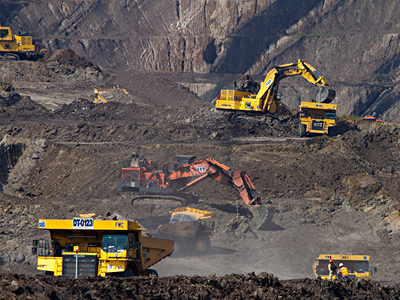Blog
Can natural resources jump-start industrialization?
At the end of last year, I filmed a lecture that will be part of a massive open online course (MOOC) on industrialization in Africa. The course is based on a joint research project between the Brookings Institution and UNU-WIDER called Jobs, poverty and structural change in Africa. The topic of the filmed lecture on natural resources and industrialization was of more than passing interest to the audience. Tanzania has discovered significant reserves of natural gas while its National Development Plan prioritizes industry. For Tanzania the question is: can gas jump-start industrialization?
 The forthcoming book, Mining for Change: Natural Resources and Industry in Africa (Oxford University Press, 2019), helps to answer that question. It addresses how the revenues and opportunities offered by natural resources can be used to change economic structure. The book features country studies on five African resource exporters — Ghana, Mozambique, Tanzania, Uganda, Zambia — and focuses on three areas of public policy central to industrialization: understanding and managing the resource boom, the construction sector, and linking industry to the resource. Here I provide some ideas about how policy, and institutional changes, along with public investment, can push the pace of structural change in a resource-rich economy.
The forthcoming book, Mining for Change: Natural Resources and Industry in Africa (Oxford University Press, 2019), helps to answer that question. It addresses how the revenues and opportunities offered by natural resources can be used to change economic structure. The book features country studies on five African resource exporters — Ghana, Mozambique, Tanzania, Uganda, Zambia — and focuses on three areas of public policy central to industrialization: understanding and managing the resource boom, the construction sector, and linking industry to the resource. Here I provide some ideas about how policy, and institutional changes, along with public investment, can push the pace of structural change in a resource-rich economy.
Understanding and managing the boom
The early questions posed by a natural resource discovery, ‘how big is the revenue likely to be?’ and ‘when will it come on line?’ are often the questions that are least well understood by politicians and the public. After a new mineral deposit is discovered it can take a decade or more to take the steps necessary for revenue to flow through to public finances. In Ghana, Mozambique, Tanzania, and Uganda, the size of the boom has been overestimated, while the delay in receiving revenues has been underestimated, leading, in the cases of Ghana and Mozambique, to rapid accumulation of debt. In addition, resource revenues tend to be highly volatile. Managing the boom requires educating the public to these inconvenient truths and avoiding the temptation to front load spending.
Because of the long lead time between discovery and revenue flow, countries have a window of opportunity to make decisions about savings rules and public expenditures and lock them in before pressures to spend become irresistible. A resource-abundant economy should never finance an investment project where the return, broadly and carefully assessed, is less than that obtained from holding foreign assets. Yet, all the countries we studied lacked effective systems to prioritize and select investment projects. To improve project selection, governments need to build a cadre of economists trained in project appraisal and make them responsible for project preparation in each spending ministry. The ministries of finance or economy should have a prioritized list of projects meeting the threshold rate of return.
Additionally, in our research we found that public investments were frequently made without adequate provision for the recurrent costs of maintenance. Because lack of maintenance can seriously degrade project returns, a medium-term expenditure framework (MTEF) that incorporates multi-year maintenance plans should be used to create budgets that are more forward looking.
 The construction sector
The construction sector
The construction sector determines a country’s ability to transform public investments into outcomes, and it has an important direct link to the natural resource sector. The extent to which the domestic economy can benefit from the construction phase of a natural resource project depends on the sector’s capacity to meet the price and quality standards of extractive investors.
A recurrent theme in our country studies is the extent to which firm capabilities — access to material inputs, skilled labour (engineers, technicians, artisans) and access to finance — limit the ability of domestic construction firms to expand production. The majority of construction firms in Africa are micro, small and medium enterprises (MSMEs), and business training (despite an uneven track record) may be one way to improve their capabilities.
Institutional and policy reforms can relieve other constraints. Where urban land rights are confused, or construction permits cause delays, governments can act. Policy restrictions on imports and poorly performing institutions, such as customs or the port, can be addressed. With planning, construction skills can be developed locally, and easing the restrictions on movement of skilled artisans within regional agreements can help to relieve bottlenecks.
Linking industry to the resource
Political pressures to ‘localize’ the benefits of a natural resource discovery is a reality faced by all resource-abundant economies. In response, African governments have adopted a wide range of ‘local content’ and ‘value added’ initiatives. Most countries have succeeded in enforcing requirements for the employment and gradual skills upgrading of nationals, but local procurement regulations have been met with less success. Resource-multinational corporations (MNCs), and their first-tier suppliers, often prefer to operate almost exclusively with foreign, second-tier suppliers. In general, local companies are found at the lower end of the natural resources supply chain, in activities such as transport services, catering and security. A ‘missing middle’ of productive small and medium enterprises (SMEs) in industry is a major reason why the extractive companies have difficulty finding qualified local partners.
Integrating local firms into the resource value chain depends on the ability of government and industry to develop effective public–private partnerships. While training can raise the capabilities of local firms to the minimum level needed to allow them to enter the MNC value chains, the government and the resource extraction companies must agree on the design of training, and on the qualification process through which a firm achieves second-tier supplier status. Without buy-in from both parties training will not be an effective strategy. Further, public officials must understand both the requirements of the procurement divisions of the MNCs, and the range of capabilities of domestic firms. A well-designed and properly staffed organization to negotiate and manage local participation— for example, a unit in the office of the head of state or government — can act as the broker between the multinational companies and domestic firms.
John Page is Non-Resident Senior Research Fellow at UNU-WIDER and Senior Fellow in the Global Economy and Development Program at the Brookings Institution in Washington DC.
The views expressed in this piece are those of the author(s), and do not necessarily reflect the views of the Institute or the United Nations University, nor the programme/project donors.
 Join the network
Join the network


